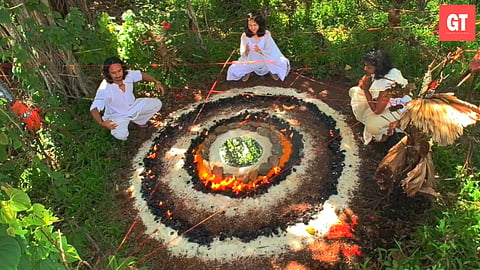

'Mandalas for Mollem' by Miriam Koshy
Gomantak Times
Several visual art forms have evolved over the centuries. In the 20th century, artists introduced video art as a genre, which emerged in the late 1960s, pioneered by Korean American, Nam June Paik, using multiple television monitors in sculptural arrangements. He worked with video walls and projectors to create large immersive environments, and exploited video technology to produce videotapes, which could be viewed on a television screen.
Wolf Vostell (1932-1998), the inventor of décollage, was the first to include working television sets in his assemblage in 1959, which radically altered artists ability to document and record their performances, giving them freedom to work outside the gallery.
UNDERSTANDING VIDEO ART
Video art encompasses diverse media, real-time computer graphics, decorative arts, installations and other disciplines of art. The main difference from conventional cinema is that it doesn’t rely on conventional theatrical cinema; it’s a visual object/experience created consciously via skill or imaginary expressions, incorporating space as a key element in narrative sequences. The audience sometimes becomes a part of the character in the film, playing an interactive role.
Among the video artists in Goa, is Miriam Koshy, who graduated in Management from Goa University in 2002, and was in charge of Gallery Gitanjali, Panjim. Says she, “As a gallerist, I realized that I wanted to create a greater space for community gatherings, which translated into workshops for books and poetry appreciation, environmental issues, cultural dances and music, which started reflecting into my curatorial practices. And, while I had exhibitions, I had collateral events, running parallel to the exhibitions, when one art fed off the other.”
ABOUT THE ARTIST
By 2018, Miriam decided to dedicate time and space to develop her own work as an artist. She conducted two workshops, where the artists realised that art is no longer an object, and one flowed into other art forms.
Nature is her inspiration, which relates to the earth and the cosmos. To our psyche, suppressed by the dogma of patriarchy, we have to balance the feminine and masculine equation, which is the only way forward.
Her film (Liminal) Asylum is a 5:03 minute film. “For me, the making of this film was cathartic and transcendental, in a coming together of the first Altamirra residency on Found Objects (Objet Trouvé), in which one line by René Magritte, ‘Everyday Objects Shriek Aloud’ struck home, and led to the setting of the various mise-en-scène, seen in the film. It’s an alchemical process, which peeks under everyday reality to look at the archetypical shadow form as the betwixt state, where you find yourself shedding all that you have been, and approaching a new way, as uncertainty marks this phase, when old ways become redundant and the new state is yet unknown,” she explains.
Miriam Koshy (right), and an installation by her (left)
Gomantak Times
The film follows an eponymous plaster cast on her solitary way across her studio, “a space of contemplation and change,” a refuge in uncertain times. This rented home is a silent witness, as well as the threshold or starting point for the figure’s adventure. Time features as a staccato supporting character, a metronome, keeping pace in the eerie stillness. We follow the cast through these rites of passage, until she returns to re-aggregate at a higher state of consciousness,” Miriam elucidates.
Goa Mangrove Art Collective had an interactive performance to collectively resurrect and take stock of the mangrove forest to mourn, resurrect and take stock of the mangrove forest ruins along the Panjim-Bambolim Highway. This collective venture was exhibited at the Hyundai Motor Indian Foundation, from March 12-14, at the Art for Hope exhibition in Delhi, felicitating 25 awardees with a grant of Rs 1 lakh. Miriam attended the event and the film moved the members of the jury and art fraternity. Curator Priya Pall felt it was one of the most exciting works to emerge.
INSPIRATION IN EVERYTHING
As a young adult, Miriam practiced martial arts, including judo and kickboxing. It was while she was recouping from an injury, that she found interconnectivity (with the fragile gauze that bound her ligaments) and poetry, which is a large part of her work.
“When going for long walks plants, speak to me. It’s a kind of meditation, a healer. I derive strength from riding my motorbike, which is movement meditation, allowing things that unsettle me to move away. Challenges are a part of life, which lead to the next step; to balance things we need to do, bring expression to bring strength, it’s a daily sadhana. It takes a storm to clear a new space in your life. Like when a mango tree got uprooted in my garden, I used the branches to make an installation with gods and goddesses, placed around a mandala. Everything around us has something to share with us. I take used tea bags and create paintings on paper, and have moved to being a full time artist.”